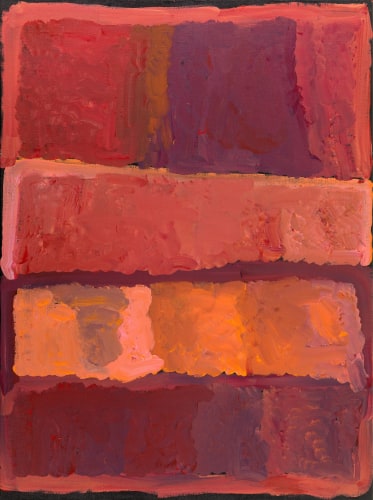Kudditji Kngwarreye is one of Australia's leading Aboriginal artists. He recounts his travels across his land in blocks of strong colour boasting outstanding aesthetic excellence. His art transcends the notions of time and place, thus reflecting true Aboriginal culture. Moreover, his paintings unavoidably draw strong associations with Western abstract art.
Kudditji's knowledge of his country is as vast as the land itself, both in a physical sense and in its history and how it came into being. Born around 1928 at Alkahare, Kudditji is part of the Anmatyerre language group, whose land is situated in Utopia, North East of Alice Springs. Early in life, Kudditji learned his peoples' 'Dreamings' and as an Elder, he taught the younger boys the practical skills of hunting as well as knowledge of the ceremonial sites in Utopia.
Whereas most Aboriginal painters depict the actual ancestral symbols from what seems to be a hovering position above the ground, Kudditji chooses to portray the essence of his land and his travels without perspective. His paintings capture the changing moods and seasons of the territory, songs, stories, hunts and the food and waterholes of the Anmatyerre country, thus uniting the earthly and timeless perceptions associated with his culture. His colour-block paintings encompass an omnipresent point of view; stripped of the notions of time and place, they seem to have no beginning and no end. This practice inevitably brings to mind Jackson Pollock's statement 'When I am painting I have a general notion as to what I am about. I can control the flow of the paint. . . . There is no accident, just as there is no beginning and no end.'
Whereas Jackson Pollock relied on his intuition and his body to infuse his images with emotional force, Kudditji interprets the timeless collective memory of his people. Aesthetically Kudditji's paintings have been compared to those of Mark Rothko and Hans Hofmann, whose Colour-Field paintings practically remain unknown to Kudditji.
In fact, during the 1970's when Utopia station was ceded to the Aboriginal people, Kudditji drove cattle and worked in various goldmines in the Northern Territory. The younger brother of the celebrated painter Emily Kame Knwarreye, Kudditji came to painting only in 1986. Initially, he assisted his sister when she developed her own original artistic style. Stimulated by the introduction of acrylic paints, Emily painted large lyrical abstracts, contradicting previous notions of what contemporary Indigenous art meant. During the 1990s, Kudditji intuitively set out to develop his famed sister's dot and line abstracts into colour-block Abstraction.
Kudditji's paintings embody the vast landscape of his country, sweltering under the extreme elements, charged with the cultural symbols and stories of his people. He celebrates a rapidly disappearing way of Aboriginal life in sensational colours, thus making his art a bright torch on the path from Utopia to the modern world.

